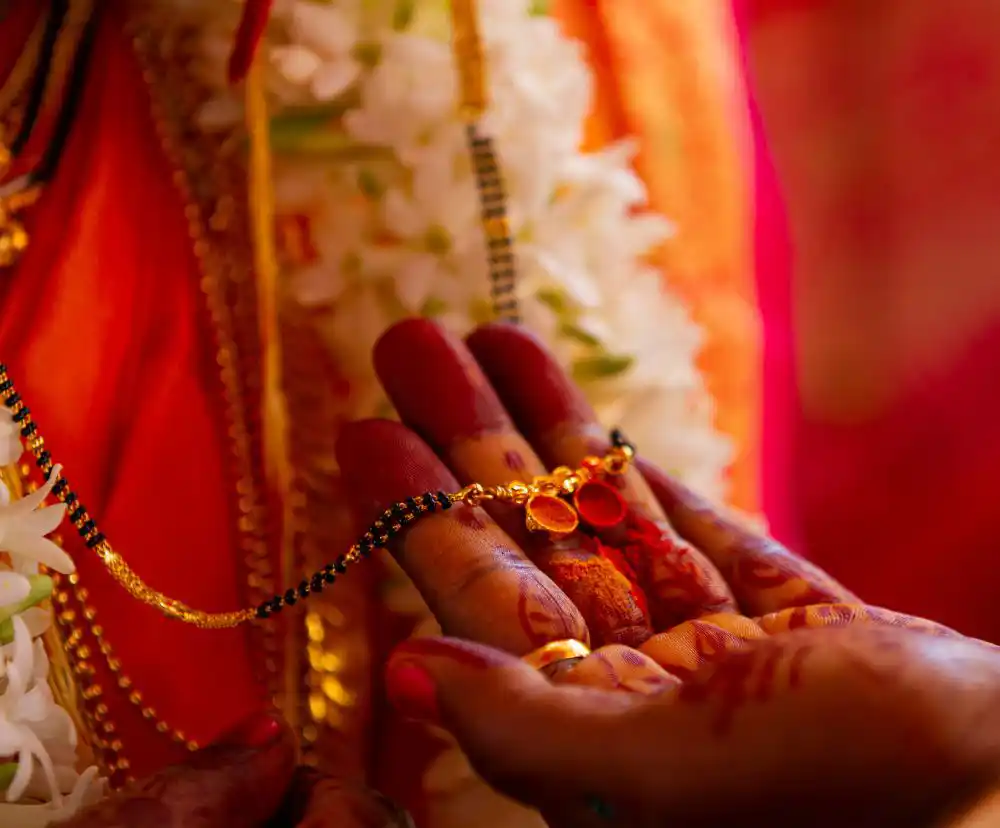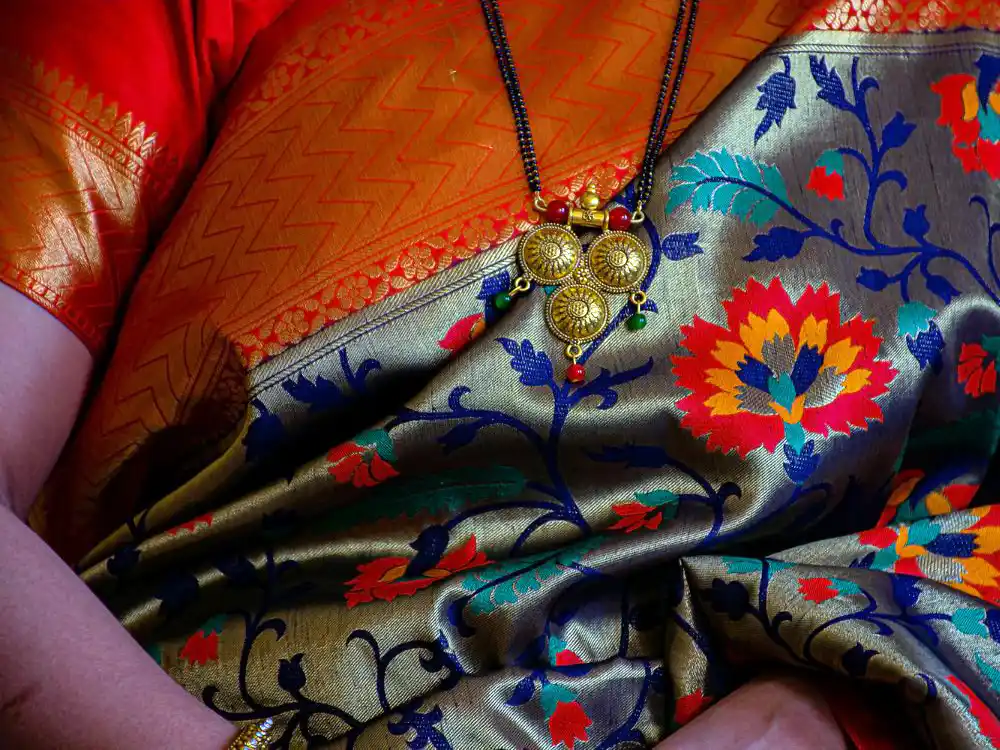The sight of a Tamil married woman adorned with a traditional gold Thali necklace is common. The Thali symbolizes the bonds of marriage for Tamil women, and its wearing is considered auspicious.
In short, the Thali can be described as a traditional South Indian wedding necklace that Tamil married women wear as a symbol of their marital status. The Thali, also known as Thirumangalyam, is a mangalsutra presented to the bride by the groom during the wedding ceremony.
What is the reason for wearing thali?
Tying the Thali around the bride’s neck during the wedding represents the sacred bond of marriage in Hindu tradition. The groom ties the Thali to signify taking responsibility for the bride’s well-being and happiness. The three knots tied in the Thali string represent the groom, bride, and their union in marriage.
The ceremony of tying the Thali is an important ritual in Tamil weddings. The groom ties the first two knots, after which his sister ties the final knot, representing the new couple’s entrance into married life together with the blessings of the family.
The Thali is believed to have spiritual benefits for married women. Its contact with the body is said to help regulate blood pressure. The black beads in the Thali are said to ward off the evil eye and absorb negative energy, protecting the woman and her family. Breaking or losing the Thali is considered inauspicious.
Tamil weddings emphasize adherence to tradition over grand celebrations. A formal engagement, known as Nishchayathram, is held where the bride and groom exchange rings and pledge to marry. The groom’s family arrives at the bride’s house for the ceremony.
In summary, wearing a Thali necklace is a treasured Tamil tradition that signifies a woman’s transition to married life. The ritual of tying the Thali by the groom and his sister is deeply symbolic and imbued with spiritual meaning. The Thali comes to represent love, respect, and responsibility within the marital bond for Tamil women.

Why a married woman should wear a mangalsutra?
Mangalsutra, a traditional South Indian necklace worn by married women, carries deep meaning and symbolism in Hindu weddings. The Mangalsutra represents the love and commitment between a husband and wife and is a sacred symbol of marriage.
The term ‘Mangalsutra’ means ‘auspicious thread’ as it combines the words ‘mangal’ meaning auspicious, and ‘sutra’ meaning thread. The gold Mangalsutra is believed to unite the souls of the bride and groom in a spiritual bond.
An important part of a Hindu wedding ritual is when the groom ties the Mangalsutra around the bride’s neck, signifying their union in marriage. This ceremony parallels the exchange of rings in Western weddings.
During the ritual, the groom ties three knots in the Mangalsutra string around the bride’s neck. The groom ties the first two knots, and his sister ties the final knot, representing the new couple’s entry into married life with family blessings.
Wearing a Mangalsutra is believed to have various benefits for married women. Its contact with the body is said to help regulate blood pressure. The black beads in the Mangalsutra are thought to ward off the evil eye and absorb negative energy, protecting the woman and her family. Breaking or losing the necklace is considered inauspicious.
The combination of gold and black beads in the Mangalsutra is believed to protect the wife and husband from any evil power. Wearing a Mangalsutra daily is considered to safeguard their relationship from negativity. It is also believed to keep the woman happy and positive by reducing stress and pain. The Mangalsutra’s effect on blood pressure regulation promotes a healthy immune system.
In summary, a Mangalsutra is more than just jewelry – it is a sacred symbol of eternal love, trust, and respect between a husband and wife. By wearing it daily, a married woman honors the bond of marriage and carries the auspicious thread signifying her union for life. The Mangalsutra thus becomes a source of blessings for the married couple.
What happens if she removes Thali?
The thali necklace forms an important part of a woman’s marriage in India. For an Indian wife, removing her thali amounts to breaking her marital bond with her husband.
When an Indian woman wears her thali after her wedding, it represents that she is now married. The placing of the thali around her neck by her husband signifies that she now belongs to him. Removing it shows that she no longer wants to remain his wife.
The thali also acts as an amulet meant to ensure a married couple’s well-being. Many Indian wives believe the thali necklace possesses supernatural powers that protect their marriage from negative energies and bring prosperity. So removal of the thali can invite misfortune.
The thali further denotes a woman’s dignity as a married lady. Removing it means losing that dignity. Many Indian husbands consider their wife’s act of removing their thali as An insult to the sanctity of their marriage and a sign of disrespect towards them. It can cause great hurt and mental agony to the husband.
Based on these perspectives, courts in India see the removal of thali as an act of mental cruelty by the wife. Some judicial verdicts have even granted divorce to husbands on the grounds of separation caused by the wife removing her thali.
The thali necklace is the most visible symbol of an Indian woman’s marital status. By keeping it on, she honors her marriage vows. Removing it signifies her unwillingness to remain a married woman and honor those vows any longer. As a result, the wife considers it a very bad omen and disrespectful act.

Why three knots in thali?
For Indian brides, the Thali ceremony is an important ritual during the wedding where the groom ties a mangalsutra necklace around the bride’s neck with three knots.
The number three holds special significance in the ceremony. The groom tying three knots in the Thali represents his threefold promises to his bride and in-laws.
First knot
The first knot signifies the groom’s promise to provide for his wife’s material needs. By tying this knot, the groom commits to taking good financial care of the bride and ensuring she lacks nothing in life.
Second knot
The second knot denotes the groom’s promise to protect his wife from all pain and trouble. It symbolizes his duty as a life partner to shield his bride from hardships and be her strength through all of life’s ups and downs.
Third knot
The third and final knot is tied by someone from the bride’s side of the family, usually the groom’s sister. It indicates the commitment of both families to the newly married couple’s well-being. The third knot affirms that the bride has a support system in her new family who will care for her needs.
Therefore, the three knots collectively signify the commitments made by the groom towards his wife and in-laws during the marriage. The groom vows to provide for his wife, protect her, and ensure she has a caring family support system.
The fact that the groom ties only two knots himself, with his relative tying the third knot, highlights the importance of both the bride’s and groom’s families coming together to nurture the newly bonded relationship.
Overall, the three knots in the Thali mangalsutra have profound spiritual meaning in an Indian wedding. They symbolize a trifecta of promises – of provision, protection, and family support – that form the core foundations for a happy married life.
When can I change my thali after marriage?
The Thali is considered a sacred symbol of an Indian woman’s marital status. Therefore, women are typically expected to wear the same Thali given to them by their husbands during the wedding.
However, in some cases, there are acceptable reasons for a woman to need to change her Thali after marriage.
The most common scenario is upgrading the Thali. At Indian weddings, the groom usually ties a yellow thread mangalsutra around the bride’s neck, which is later replaced with a gold chain mangalsutra. This upgrade happens over time as per the husband’s convenience and budget.
In another scenario, if a woman’s original Thali gets damaged or lost, she may need to replace it immediately to avoid any superstitious bad omens. In such cases, her husband often gifts her a new Thali to continue symbolizing their marital bond.
On special occasions like Aadi Perukku in Tamil Nadu, some women change just the yellow thread string of their Thali necklace, keeping the black beads of the original Thali. This change on an auspicious day is believed to bring more happiness and prosperity into the marriage.
However, any change to the Thali should only be done with the husband’s permission and blessings. The replaced Thali must continue signifying the woman’s marital status and upholding the sanctity of her marriage. The Thali itself remains a symbol of dignity as a married woman, irrespective of material changes.
In conclusion, a married woman can appropriately change her Thali necklace only under certain conditions – to upgrade it over time, replace a damaged one or change just the string on auspicious days.
But the act of changing the Thali itself should always be done with the utmost care, respecting the symbolic importance and significance attached to it by tradition. Only then will it continue honoring the woman’s role and responsibilities as a married wife.

Summary
The Thali necklace is a traditional South Indian wedding necklace worn by Tamil married women to symbolize their marital status. Tying the Thali during the wedding ceremony represents the sacred bond of marriage.
The three knots in the Thali string represent the groom, bride, and their union. The Thali is believed to have spiritual benefits and protect the woman and her family.
Removing the Thali is seen as breaking the marital bond and can have legal consequences. The three knots in the Thali signify the groom’s promise to provide, protect, and support the bride.
Changing the Thali is acceptable under certain circumstances, with the husband’s permission, and while maintaining its symbolic meaning.
FAQ
What happens if mangalsutra breaks by mistake?
Breaking of Mangalsutra is considered a bad omen in South India. The black beads in the mangalsutra are believed to become heavy due to the weight of the distressing energy, and it is an ominous sign.
Can we wear 2 mangalsutra?
There is no specific rule against wearing two Mangalsutras, but it is not a common practice. The Mangalsutra is a sacred symbol of love, respect, and dignity, and it should be treated with utmost care and respect.
Can we remove mangalsutra while sleeping?
There is no strict rule against removing the mangalsutra while sleeping, but it is considered to be more auspicious to wear it at all times. However, some women may feel uncomfortable wearing it all the time and choose to remove it occasionally.
Do Muslims wear mangalsutra?
While some Islamic scholars believe that wearing the mangalsutra is permissible for Muslim women, it is not a traditional practice in Islam. The mangalsutra is a sacred piece of jewelry that has a lot of emotional value and is associated with Hinduism. Muslim women may choose to wear other types of jewelry that align with Islamic traditions.



